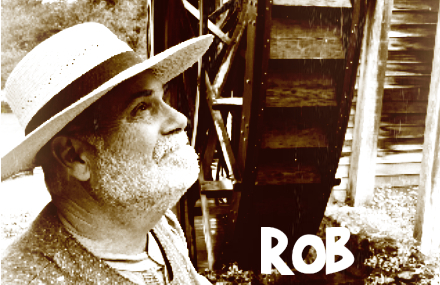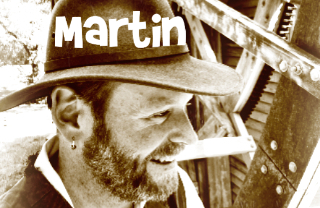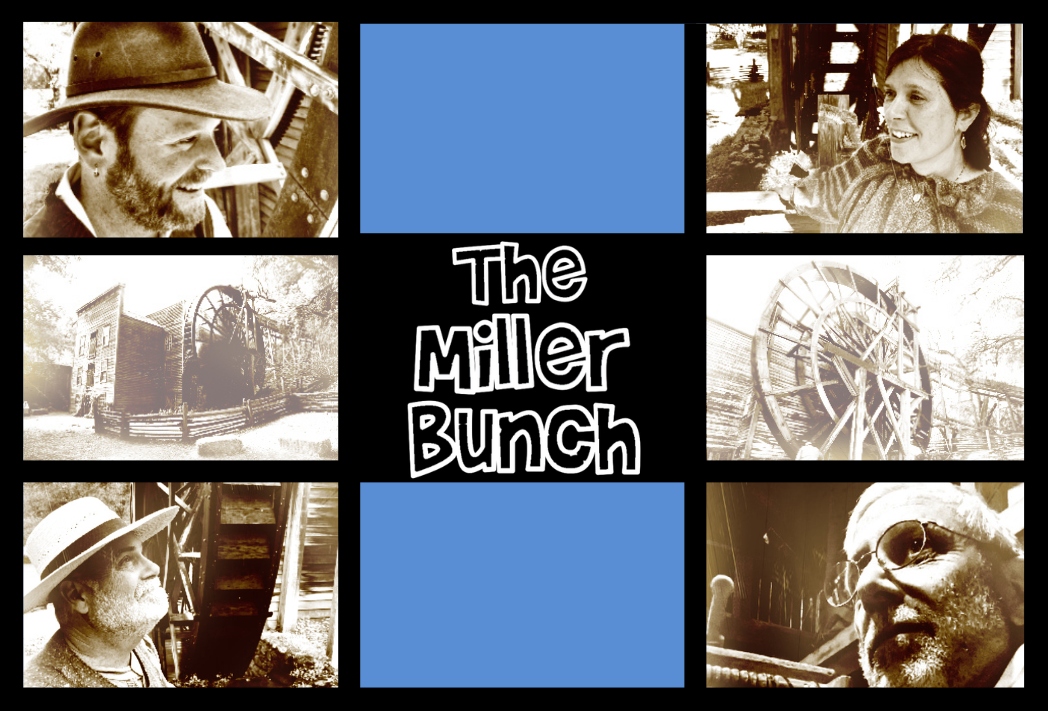The Miller Bunch
Not every open space district out there has an old mill to run, but the Napa Open Space District sure does. Most of you are likely familiar with the Bale Grist Mill from the events we promote such as the Pancake Breakfast, or Old Mill Days in October. Or maybe you’re lucky enough to have memories of a field trip you took as a child, or one where you accompanied a child. Or maybe you drove by it for the umpteenth time and finally stopped to take a tour. And then you brought your friends and relatives.
If you haven’t done any of the above, what are you waiting for? The mill has been there almost 180 years waiting for you to visit! It was a social center back in its heyday, and it still thrives when there is a lot of company around.
As you can imagine, to use a not so 1846 word, it takes a special skill set to operate and care for an old mill. And a willingness to get some flour spillage on your period appropriate clothes. So, in addition to reminding you about the mill itself, we want to introduce you to our district millers who’ve come from divergent backgrounds and interests to be given the old school (and very cool) title of . . . Miller. Read on to see how this special group got together to become the Miller Bunch!
We asked our millers how they got interested in milling, and tried to encourage them to spin a couple yarns about their experiences. Below is a sampling of our Q’s and their A’s to get to know them better. You can read their full interview responses below, or better yet, visit the mill on a weekend and take a tour with them!
 Rob Grassi
Rob Grassi
What is your day job, or, if retired, what was your previous work?
Well my day job is with the Napa Open Space District as a Park Maintenance Specialist at Bothe-Napa Valley State Park and the Bale Grist Mill.
I worked for 14 years at Hanford Mills Museum in New York as the Head Millwright. It’s a historic water and steam powered mill from the 1840s which operates as a saw mill, grist mill and woodworking machine and we had 6-8 interpreters on staff and did a lot of educational events and tours similar to what we do here at the Bale Mill.
How did you get interested in milling?
Mills are something that I’ve just always been interested in since I was a child. I’ve always loved history and technology and was fascinated by things like clocks. There was an old mill that I used to hang out near when I rode my bike when I was a kid, and my parents were very supportive of anything that my siblings and I were interested and used to take us on trips to historic sites like Williamsburg to foster the things we were interested in.
What prepared you the most to become a Miller?
Well my lifelong interest in these historic mills set the stage, and then when I had the opportunity to apprentice with a fifth generation miller when I was in my late teens I jumped at it. The millwright that I apprenticed with was from Staffordshire, England, and had been working since the 1970s I think for Historic Hudson Valley. For a lot of my professional career, this was part-time work and I always had other jobs doing woodworking, finish carpentry, and things like that as well.
We’re not saying you’re moonlighting, but have you worked at any other old mills. If so, which is/was the most interesting?
Gosh that’s a tough one, they’re all so different and all interesting in their own ways.
One that always stands out to me is a horse powered mill in Bethlehem, Pennsylvania. It’s designed to hook up up to four horses to, and they turn a shaft that’s connected to an enormous gear that turns another gear and then you can power really anything you want off that. It’s a power source for this old mill and was integral to that farm. They drove saws, threshing machines, a water churn, really anything you might need power for could be done on it. I got to work on restoring that mill and to get to see that operating again was really something, you just don’t see things like that much anymore.
Another one that’s interesting for very historic reasons is the mill at Mount Vernon. I get to go back and work on that every couple of years and do some maintenance and tuning up on the millstones. It’s a very historic site, obviously, and I help keep the millstones in good working shape, rebanding them, truing them up, balancing them – really the same kinds of things we do here at the Bale Mill.
Your favorite article of period appropriate clothing?
I would have to say the vest. What intrigues me about the vests, more than say the shirts or hats, is that in the early to mid 19th century, a man wasn’t considered dressed unless he had his vest on. You might have taken it off if you were out plowing in the hot sun or something, but otherwise you started your day with it on when you went out the door and still had it on when you came back home.
 Mario Scalise
Mario Scalise
What is your day job, or, if retired, what was your previous work?
I’ve been retired for ten years but my career was in IT. Among other things I worked as a tech director and also a data center architect at large tech companies in San Francisco. And I also describe the Bale Mill as high technology. If visitors scratch their heads I ask them to politely bring that smartphone in their pocket back to the mill in ten years and we will discuss what an antique it has become.
How did you get interested in milling?
My grandpa was a grist miller in Calabria, Italy and my great grandfather built six mills in his lifetime. I’ve been to the mill in the village my mother was born in, it is a horizontal Greek water wheel design with a water tower and it’s still standing but it’s long been abandoned. I first visited the “Old Bale Mill” over 60 years ago. My family, including my grandfather, would have picnics at the mill in the summer. It was completely closed up in those days and there was a horseshoe entrance off highway 29 and a few picnic tables.
What prepared you the most to become a Miller?
My family had a vineyard in Calistoga in the 60’s and we would haul grapes to the old Napa Valley Co-op Winery. It was hard work and especially in those days, much more like dirt farming than the glamour of it all that it is today in the Valley. I have had an appreciation for farming and the harvest since I was a kid.
What is the most interesting thing that has happened when you’ve been milling?
Meeting people from around the country and around the world and gaining and sharing knowledge about early Napa Valley history.
We’re not saying you’re moonlighting, but have you worked at any other old mills. If so, which is/was the most interesting?
I’ve been to several SPOOM (Society for the Preservation of Old Mills) conferences which have had miller training sessions. The training and comradery with other millers has been a very rewarding experience. As for any other old mills, the most interesting involved a visit to the ASTRA National Museum Complex in the Transylvania region of Romania. The ASTRA has over 50 restored grist and windmills to visit in a wonderful park setting.
Your favorite article of period appropriate clothing?
Generally just our usual period dress works fine. However, if it’s August and around 100F, then it’s definitely shorts and a Bale Mill T-shirt.
 Christin Tanner
Christin Tanner
What is your day job, or, if retired, what was your previous work?
I have 20 years of tour guiding experience and started out working with student tour companies, primarily 4th grade students touring sites in Sacramento. This mill fits right into that experience.
What is the most interesting thing that has happened when you’ve been milling?
As I was talking about how a Donner party survivor, Sarah Graves Fosdick, was the first school teacher in the first school in the Napa Valley across from the mill, I had a guest tell me her ancestor was Mary Graves, another survivor and Sara’s younger sister.
Your favorite article of period appropriate clothing?
As a woman, period clothing was hazardous for their health. I encourage readers to look up Dingley’s Mill in what is now Solano County, one of many examples of what could happen with long skirts. The most comfortable for me is current clothing.
Editor’s note: There are historical notes that in 1864, during a tour of the Dingley Mill, a young woman was leaning over one of the hoppers when her dress was caught in the revolving machinery of the mill and she was tragically killed.
 Martin Podell
Martin Podell
What is your day job, or, if retired, what was your previous work?
I am the Head Baker at The Model Bakery in Napa.
How did you get interested in milling?
It was part of my progression as a baker, I had started with milling small amounts of local grains into flour for use at the bakery. I then took a tour of the Bale Mill and wanted to learn more of its history
What prepared you the most to become a Miller?
It was a natural fit for my profession. I have always been interested in history and how food\lack thereof has been part of shaping it. The mechanical aspects of the Bale Mill were also very interesting to me.
What is the most interesting thing that has happened when you’ve been milling?
Besides learning about the history and operations of the Bale Mill, the most interesting and rewarding part of being a miller is having the opportunity to speak with our visitors and share the milling experience. I have also been learning to hand dress mill stones, that is a skill I now use outside of the Bale Mill.
We’re not saying you’re moonlighting, but have you worked at any other old mills. If so, which is/was the most interesting?
Old Mills, no. But I continue to stone mill flour at the Bakery, and mill flour for several local grain farmers on a new stone mill in Sonoma County.

